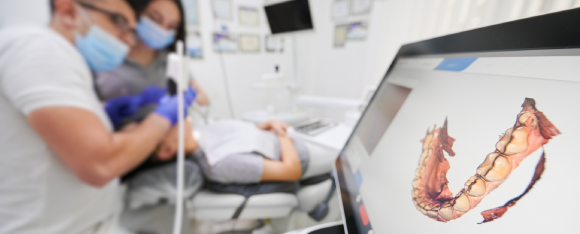The January Oral Wellness newsletter is brought to you by United Concordia,
proud provider of Pennsylvania Farm Bureau dental insurance coverage.

January 2022

Kick off 2022 by kicking bad habits
By Dan Tison, Oral Wellness Consultant, United Concordia Dental
As we ring in the new year, most of us feel inspired to set new goals and make positive changes in our lifestyles. Some of the most common resolutions revolve around getting healthier. You may vow to lose weight, exercise more or eat less sugary snacks – something that’s good for your oral health, too.
But despite all that early motivation, many people find it difficult to actually accomplish what they had in mind. Oftentimes, the reason it’s so hard is because we’re just not mentally ready to change, even though we want to.
But why are some people so good at kicking their bad habits to the curb? Research shows that folks who succeed go through a specific cycle of change, moving from one stage to the next until they achieve their goals.
If you’re feeling stuck in place, check out the five stages of change below. Once you understand where you fall in the cycle, you can map out ways to move forward in your journey to create better habits.
The 5 stages of change*
- Precontemplation: Not seeing that change is needed
- Contemplation: Seriously considering better habits
- Preparation: Planning how to make changes
- Action: Taking action to create new habits
- Maintenance: Sticking with new habits for longer than 6 months
Let’s say you’ve accepted that you need to stop smoking – Stage 2 – but you can’t imagine quitting cold turkey. Start preparing for your change – Stage 3 – by exploring options such as nicotine patches, hypnosis or even acupuncture. When you find a solution that seems doable, you’ll feel confident about taking action and quitting for good.
*Prochaska, J.O., Norcross, J.C., and Diclemente, C.C. Changing for Good: A Revolutionary Six-Stage Program for Overcoming Bad Habits and Moving Your Life Positively Forward, Quill House Publishers, Rock Hill, SC, 1994.

The Oral Systemic Connection
It’s a fact. There’s a direct connection between the health of your mouth and the health of your whole body. Makes sense, right? Wellness is based on the body as a system, and the mouth is an important part of this system. Dental problems like gum disease can complicate chronic medical conditions such as diabetes, heart disease and rheumatoid arthritis. And those conditions can make it harder to manage your gum health.
Gum disease, common but largely preventable, happens when the bacteria in plaque cause inflammation of the gums, which can affect the areas that support your teeth. As untreated gum disease progresses to periodontitis—a more serious condition—it can even lead to bone and tooth loss.
United Concordia Dental has conducted research that looks at how preventive dental care can affect overall health, according to the average member’s insurance claims data. We analyzed three years of data from over 489,000 members who have United Concordia dental insurance and Highmark medical insurance and uncovered significant correlation between preventive dental care compliance and medical claims costs. Study participants who received the proper preventive dental care for three consecutive years had lower total medical costs than those who saw the dentist only once in three years or not at all.[1]
So if you have a chronic medical condition, it’s especially important to prevent or treat gum disease. That’s why we offer the Smile for Health®-Wellness program, which offers more coverage for members with certain chronic medical conditions to help them get the periodontal services needed to properly treat gum disease.
Want to get an idea of how healthy your mouth is? Take our quick quiz to learn how your dental care routine and medical conditions may be affecting your oral health.
- Value of Going to the Dentist. United Concordia Dental internal research. September 2017.

Thyroid Disease and Your Oral Health
What’s small, butterfly-shaped and wraps around your windpipe? It’s your thyroid gland, an organ that secretes hormones which control vital body functions like your metabolism.
If your thyroid gland shifts into overdrive or slows down, it can wreak havoc on your entire body. Not only can undiagnosed or untreated thyroid disease put you at risk for serious conditions like heart disease, osteoporosis and infertility, it also can cause mouth and dental issues. [1]
Unfortunately, almost 60% of people with thyroid disease don’t know they have it. And women are five to eight times more likely to develop the condition than men.
Luckily, your dentist may be the first one to spot thyroid issues during an exam. Your dentist may notice oral symptoms such as a dry, discolored, coated or painful tongue.[2] If thyroid disease is suspected, the dentist may want to consult with your doctor or an endocrinologist. And if you have gum disease, your dentist may suggest getting a blood test to check your thyroid-hormone levels. [3]
Two common thyroid diseases
Hypothyroidism
Also called “underactive thyroid”, hypothyroidism can make you feel tired, gain weight and become forgetful or more sensitive to cold. [4] About half of the people diagnosed with dry mouth also have thyroid disease. And medications taken for thyroid disease can cause dry
mouth, which may lead to mouth sores, tooth decay, bad breath and difficulty swallowing. [2, 3] Other oral symptoms include:
- An enlarged tongue
- Gum disease
- Slow healing mouth sores
- Increased risk of mouth and tooth infections
- Distorted taste
- Delayed tooth growth in children
Hyperthyroidism
An overactive thyroid can cause weight loss, trouble sleeping, sensitivity to heat, plus nervousness and irritability. One oral condition called “Burning Mouth Syndrome” is also linked to hyperthyroidism and most common in middle-aged and menopausal women. This syndrome can make your lips, tongue or mouth feel like they’re burning, plus cause a bitter or metallic taste. Other oral symptoms of overactive thyroid include: [3]
- An increase in cavities
- Enlarged thyroid tissue on the tongue and throat
- Osteoporosis in the jaw
Rapid tooth growth in children
Your dentist can help
If you’ve already been diagnosed with a thyroid disorder, medication can restore your thyroid hormone level to normal. The right medications can also help prevent and heal oral side effects.
Make sure to let your dentist know about your condition, including any medications you’re taking, before undergoing any dental procedures. If you take medication for a secondary issue like heart disease, it could affect how your blood clots or how you respond to anesthesia.
It’s also important to have your dentist monitor any oral symptoms of thyroid disease. He or she can recommend lifestyle changes and over-the-counter medication that can help. Your dentist also can remind you when to have your primary care doctor check your thyroid hormone levels. [5]
Sources
1. Readcube; Oral Manifestations of Thyroid Disorders and its Management, January 2016, accessed December 2021.
2. Verywell Health. How Thyroid Disease Causes Dry Mouth, July 202, accessed December 2021.
3. My Health System, Thyroid Problems and Oral Health, accessed December 2021.
4. Distinctive Dentistry, The Health of Your Thyroid can Impact Your Oral Health as Well, July 2021, accessed December 2021.
5. Cleveland Clinic, Thyroid Disease, April 2020, accessed December 2021.

New Technology at the Dentist’s Office
From smart phones and robot vacuums to virtual assistants that answer your voice commands, tech gadgets have transformed how we live, work and play.
Modern technology is showing up in the dentist’s office, too. Several new advancements are helping to make visits quicker, less nerve-wracking and less painful. Believe it or not, your next dental appointment really could seem like a day at the beach.
Virtual reality relaxation
No one likes to stare at glaring lights or hear the sound of whirring tools during their appointment. To create a more soothing atmosphere, some dental offices offer virtual reality headsets as a distraction.
With virtual reality relaxation, patients wear a goggle-like device that lets them watch their choice of calming content. Depending on the system, you might be transported to a tropical beach or a serene sunset scene. Whatever your escape, the experience will likely make you forget you’re sitting in the dentist’s chair.
3D-printed crowns
In the past, the dentist had to cast a mold of your tooth and then ship it off to a lab to have the crown made. You’d be fit with a temporary crown while you waited – sometimes as long as two weeks.
Now, using desktop 3D printers, dentists can make permanent crowns right in the office in just minutes. This technology also can be used to make implants, veneers, aligners and retainers.
Infrared imaging to detect cavities
To find cavities, dentists typically rely on x-rays and a tool that checks for soft spots on tooth enamel. But x-rays don’t always show very early surface cavities. With infrared imaging, the dentist glides a wand over the teeth, bathing them in safe, near-infrared light. While the images captured look similar to x-rays, they illuminate small or minor areas of decay, so you can get treated earlier.
Laser dentistry
Dental lasers can be used to remove cavities, whiten teeth and treat gum disease. Lasers work by aiming a narrow beam of light at decay, enamel or tissue. The light reacts with the area being treated, allowing it to be removed or reshaped.
When used for surgery, the laser “vaporizes” tissue by heating it up versus cutting with a scalpel. So, it’s less invasive and pain is almost non-existent.
3D X-rays
Preparing for some procedures such as a dental implant, root canal or braces require more detailed images than traditional x-rays can capture. In those cases, the dentist may use cone-beam computed tomography (CBCT) to get a precise look at your soft tissues, nerves and bones.
With CBCT, a scanner rotates around your entire head, taking between 150 to 700 panoramic images, which are digitally combined to form a 3D image.
Check your dental coverage first
All dental offices are different, so yours may or may not have these capabilities. Remember to check your dental insurance to see if these services and procedures are covered by your plan.
Just log in to your MyDentalBenefits account, and look under the Covered Services tab.

Prep time: 15 minutes
Serves 6 (358 calories per serving)
Ingredients:
Kosher salt, as needed, plus ½ teaspoon
1 large head cauliflower, cut into small florets
Vegetable oil spray
1 cup heavy cream
2 ounces cream cheese, cut into small pieces
1 ½ teaspoons Dijon mustard
1 ½ cups shredded sharp cheddar cheese, plus ½ cup for topping the casserole
¼ teaspoon freshly ground black pepper
⅛ teaspoon garlic powder
Directions
- Preheat oven to 375 degrees F. Bring a large pot of water to a boil. Season the water with salt.
- Spray the baking dish with vegetable oil spray.
- Cook the cauliflower in the boiling water until crisp-tender, about 5 minutes. Drain well and pat between several layers of paper towels to dry. Transfer the cauliflower to the baking dish and set aside.
- Bring the cream to a simmer in a small saucepan, and whisk in the cream cheese and mustard until smooth. Stir in 1 cup of the cheese, salt, pepper, and garlic, and whisk just until the cheese melts, about 1 to 2 minutes. Remove from heat, pour over the cauliflower, and stir to combine. Top with the remaining 1/2 cup cheese and bake until browned and bubbly hot, about 15 minutes. Serve.
Courtesy of foodnetwork.com
Stay Connected. Stay Healthy. |
